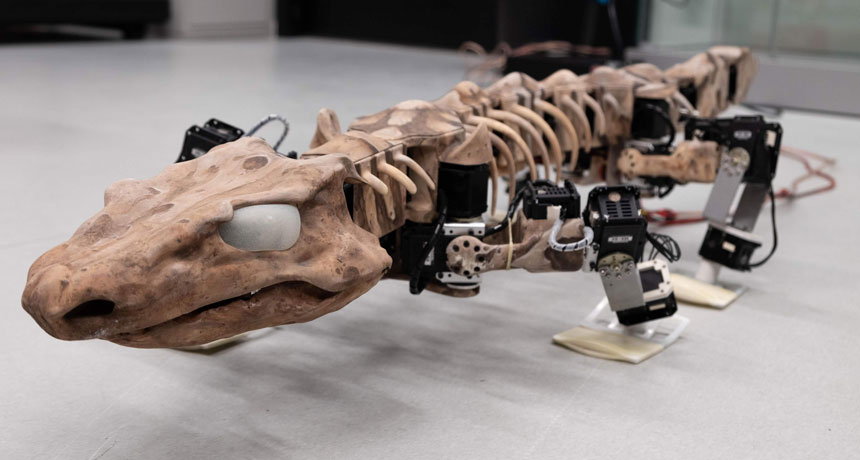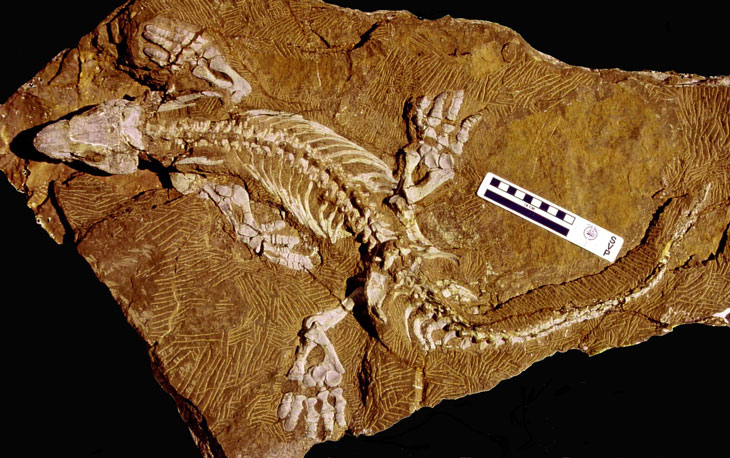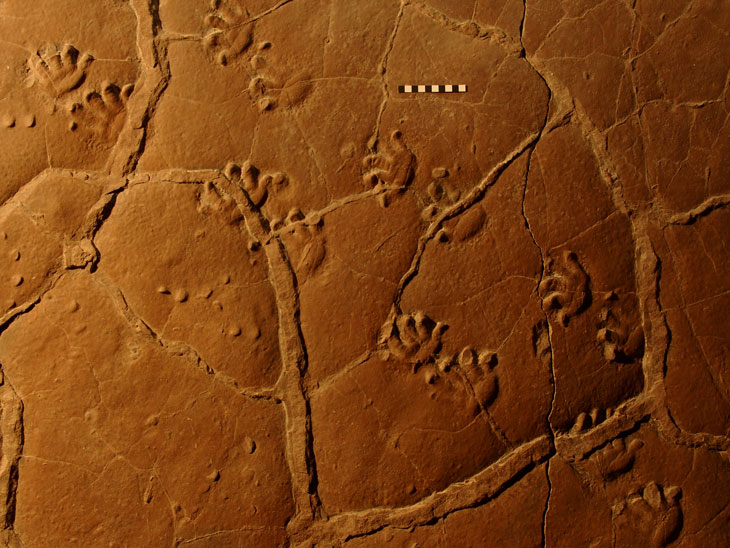Orobates pabsti may have had a more developed gait that previously thought

ROAMING BOT Researchers designed a robot called OroBOT to re-create and analyze different gaits that Orobates pabsti, a four-legged creature that lived about 290 million years ago, might have used.
Orobates pabsti lived between 280 million and 290 million years ago, but it was pretty advanced at doing the locomotion.
Using computer simulations, re-created skeletons, fossil trackways and a walking robot dubbed the OroBOT, scientists found that this ancient four-footed creature had a surprisingly efficient gait. The result suggests that developing a more advanced way of walking may not have been as closely linked to the later diversification of tetrapods as once thought, the researchers report January 17 in Nature.
Scientists care about how O. pabsti might have moved because the animal was one of the earliest amniotes, a group that arose around 350 million years ago and includes both reptiles and mammals. Unlike amphibians, which have aquatic young, amniotes can live entirely on land. Protective membranes surrounding embryos allow amniotes to bypass a tadpole-type life stage in water: Reptile (including bird) eggs can be laid on land in nests; mammal embryos stay within the mother.
The amniotic membrane “is regarded as a key evolutionary innovation, to be able to colonize different habitats,” says John Nyakatura, an evolutionary biologist at the Humboldt University of Berlin who led the new study.

Understanding how early amniotes walked on land could help scientists better understand the origins of amniotes themselves, and how they eventually diversified across the continents, Nyakatura says. “Orobates, our focus fossil in this story, is a very close cousin to the last common ancestor of mammals and reptiles,” he says.
Researchers first described O. pabsti in 2004, following the discovery of beautifully preserved fossils of the creature at a site in central Germany known as the Bromacker locality. “The preservation is phenomenal,” says Stuart Sumida, a vertebrate paleontologist at California State University, San Bernardino who was not involved in the new study. “These are things preserved from the tip of the nose to the tip of the tails,” Sumida says. “They are so well preserved that we can generate hypotheses about how they moved.”
Then, a few years later, researchers linked the creatures to a series of footprints, called a trackway, found at the same locality, offering more clues to how the animal might have walked.

But there’s more to visualizing walking than knowing where an animal put its feet. Various approaches are used to study the locomotion of extinct animals, including examining their anatomy from fossils, studying trackways (SN: 1/30/10, p. 9) or even building robots, says study coauthor Kamilo Melo, a bioroboticist at École Polytechnique Fédérale de Lausanne in Switzerland. But what’s different about the new study, Melo says, is that the scientists have combined several of these tactics to get the best possible approximation of an ancient creature’s gait.
The researchers first re-created the skeleton of the creature and used it to constrain the possible ranges of motion of arms and legs, called a kinematic simulation. “You create a marionette, and see what amount of angle each joint can move,” Melo says. And the scientists created a dynamic simulation, which included factors such as gravity, friction and balance, to really examine how the animal might have walked.
The team also looked to modern four-footed species, including salamanders, skinks, caimans and iguanas, to examine possible ranges of motion for tetrapods. Skinks and salamanders, for example, hold their bodies lower with their limbs more sprawled out to the side while caimans tend have more erect limbs.
Finally, the scientists created a tetrapod robot, dubbed the OroBOT, to act out potential gaits and match the prints they’d create to the fossil tracks. The researchers ultimately considered 512 different possible types of movement, scoring them on scales such as energy consumption, balance and precision — how well the gait reproduces the fossil tracks without slipping or sliding. (The researchers have also put their digital simulation online; try out different gaits here.)
The data suggest that O. pabsti had a relatively advanced style of walking, one that researchers previously thought would have belonged to later tetrapods. It held its belly off the ground, and had a stable, efficient gait without a lot of side-to-side, salamander-like undulations. That style of walking probably helped the animal conserve energy.
Sumida praises the study’s multipronged design, which allowed the scientists to test their findings in multiple ways, from fossil to digital simulations to robot. Furthermore, he notes, the team’s biomechanical analysis has confirmed something that previously was strongly suspected only by the fossil’s finders: that O. pabsti was indeed a fully terrestrial animal that probably had a relatively modern gait.
Sumida and others have demonstrated that amniotes from the same locality were using a range of different walking styles. Some had erect limbs like O. pabsti, some sprawled, and at least one animal walked on two legs. “What these studies are showing is that when amniotes first showed up, they were doing lots of things more quickly than we ever realized,” he says.
The findings are just a start, Nyakatura says. The researchers hope their multipronged approach will be a jumping-off point, not only for scientists to better understand O. pabsti, but also to examine other ancient locomotive puzzles, such as the evolution of active flight, bipedal locomotion in human ancestors and the transition from terrestrial to aquatic in marine mammals. “We have a whole bag of interesting things to study,” he says.